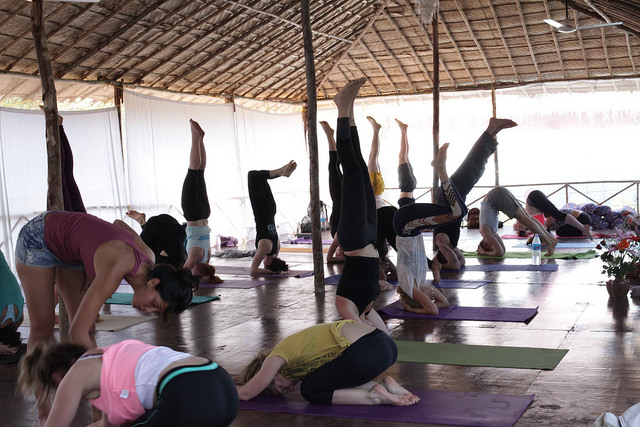Yoga teachers come in many shapes and sizes.
My first class was taught by a lovely, round lady who sat on a stage at the front of the room and never moved once.
These days, the typical image of a yoga teacher is a Lululemon-clad inverted Instagram beauty, hash-tagging “peace” with a prayer emoticon.
My previous article, “Confessions of a Not-So-Perfect Yogi,” seemed to resonate with many people, so I thought I would elaborate on the challenges I have come across as a “less-than Instagram-ready” yogi.
My first yoga job ever was in Prague.
I was subbing for a summer—for teachers on holiday—in a boxing gym. I was 24 years old and newly-qualified. The owner asked me to attend one of the teacher’s classes, to see what she did and get a feel for the class.
This teacher shouted at one of her students in stressed exasperation, like the student was an idiot for not understanding her instructions.
I was enjoying a pose she called “figure-of-eight” pose—lying on my back circling arms and legs in opposite directions—but when I opened my eyes, I saw her glaring at me fiercely. Still, after the class I went over to thank her.
“What do you want to tell me?” she asked, coldly and dismissively. (I can’t remember what I replied.)
“I have serious Ashtanga students that will tear you to pieces,” she said. “You look like a beginner! You don’t even know figure-of-eight pose! A basic Iyengar pose!”
I was shell-shocked.
I went to speak to my teacher trainer who laughed. “Tear you to pieces?” She said. “That’s nice.”
My trainer had also never come across figure-of-eight pose, despite studying for years with an expert in Iyengar yoga. (And I have never come across it again, since.)
However, this woman was my best teacher.
I went home, and I felt horrible—but I stuck with it. I subbed and taught classes there to Czech students, knowing only a few Czech words that I had learned by attending other yoga classes taught in Czech. The words,“Breathe in, breathe out—very good, one more time. Left, right, up down, forwards and backwards,” can get one quite far when teaching yoga in a foreign language, I soon discovered.
When the original teacher returned from abroad, the owner wanted to keep us both on teaching. Once, I asked her to sub my class. “Cancel your class, and send them all to mine,” was her brisk reply.
Over the years, since I left Prague, many other teachers have had similar issues with her. (One teacher told her not to call again, until she had been to therapy.) It took me years to realise that it wasn’t only me she had communication issues with.
This experience helps me remember to try things, even if people tell me I can’t. To stick with things, despite someone saying I shouldn’t or that I’m not good enough. Nothing will be learned from listening to any voices—internal or external—that say “you can’t.”
However, I was so determined to succeed at teaching yoga, in this embryonic stage of my “career,” that I pushed too hard.
For example, I tried daily to do headstand—even once when I was at the beginning of my menstrual cycle. (Which is a time, yoginis are advised not to invert.) Headstand is no longer a pose I practice, but at the time, I felt that I had to master it, because one of my sisters had once said to me, “What kind of a Yoga teacher are you, if you don’t do headstand?”
This rocked my confidence.
Then one day, when my other sister put her legs across my lap, I realised what I had always suspected—that my family tend to have heavy leg bones.
Sometimes, when adjusting people in savasana—I pick up their legs. Althought they are relaxed, some people’s legs feel light as feathers, whilst others feel as if they’re made of lead. The difference is remarkable, yet we expect them all people to be able to perform a headstand by simply engaging the right bandhas.
As new teachers, we are like fragile saplings—needing a protective fence around us, consisting of stronger, more experienced teachers or supportive friends. After some years, we will find our own strength, and the negative comments start to have less of an effect.
As the time passes, we attain confidence that we are on the right path. If you are a new teacher, and suffering from doubts about your teaching or practice, know that this is normal and healthy!
For instance, I would much rather have a teacher who is unsure about having the answers, over one who believes they know it all already, and doesn’t therefore listen.
It is tempting to try to please everyone—especially as a newbie, just starting out—but teachers need to be authentic. We must be willing to let go of what is not meant for us, but also willing to stand up for ourselves, when others try to knock us down.
As for those Ashtanga yogis that were going to “tear me to pieces”—I never did meet them.
.
Relephant reads:
A Yoga Teacher Training Certificate is Just the First Step.
Life Lessons from my 200-hour Yoga Teacher Training.
.
Author: Hannah-Marie Martin
Editor: Yoli Ramazzina











Read 2 comments and reply